Having launched Camunda Cloud in early May, we’re excited by the significant early results in product adoption. Additionally, only two months after GA, we continue building on the capabilities of Camunda Cloud and are releasing the next version of our innovative process automation SaaS offering. We’d like to take this opportunity to share some of the early results while also highlighting new features in Camunda Cloud 1.1:
- 2500+ Camunda Cloud Free trial signups since GA
- Camunda Cloud 1.1 features:
- Improved business-IT-collaboration with support for all relevant BPMN Task types along with improved visibility for call-activity
- Advanced smart low-code functionality with the ability to create more complex forms using Camunda Forms
- Improved user experience and instant upgrade to the Camunda Cloud Professional Plan with a self-service credit-card purchase option – no need to talk to a sales person.
- Now available in Camunda Cloud as Beta:
- Real time visibility into processes with Optimize, multi-process reports and dashboard default filters
- Camunda Cloud 1.1 also includes:
- Zeebe 1.1.0
- Operate 1.1.0
- Tasklist 1.1.0
In this post, we’ll highlight some of the new capabilities introduced in this minor release.
- Improved Business-IT-collaboration
- Advanced smart low-code functionality
- Improved user experience with Camunda Cloud Professional
- Real time process visibility
- Further Improvements
- How to get it
Improved Business-IT-collaboration
One of our key goals is to improve Business-IT-collaboration by facilitating the BPMN standard. We’re pleased to report that with this release, we’ve added Business Rule, Script and Send tasks, meaning Camunda Cloud now supports all the relevant BPMN Task types.
A Business Rule task is used to show that the task evaluates business rules, for example, a DMN decision. Script tasks are used to indicate that the task evaluates a script, such as a script written in Groovy, JavaScript, or Python. A Send task is used to publish a message to an external system, to a Kafka topic, for instance.
All three new tasks behave exactly like service tasks. All define the same properties, like job type, custom headers, and variable mappings. They can be processed by writing a job worker for the given job type, in the same way as for service tasks.
The new tasks can be modeled using the latest release Camunda Modeler 4.9.0 directly in the Camunda Cloud Console Modeler.
Besides the newly supported task types, we’ve improved the visibility for call activities in Operate. A call activity references another process definition, which is invoked once the parent process enters the call activity. With the latest release of Operate, the user interface (UI) enables users to easily navigate inside the process hierarchy — in the parent process the call activity metadata pop-over contains a link to the child instance. Similarly in the called instances the instance details header now contains the parent instance ID. In the instances list view, the user can now filter by the parent process instance ID to find all instances which were started by a specific instance. The list also contains a new column which references the parent instance if any exists.
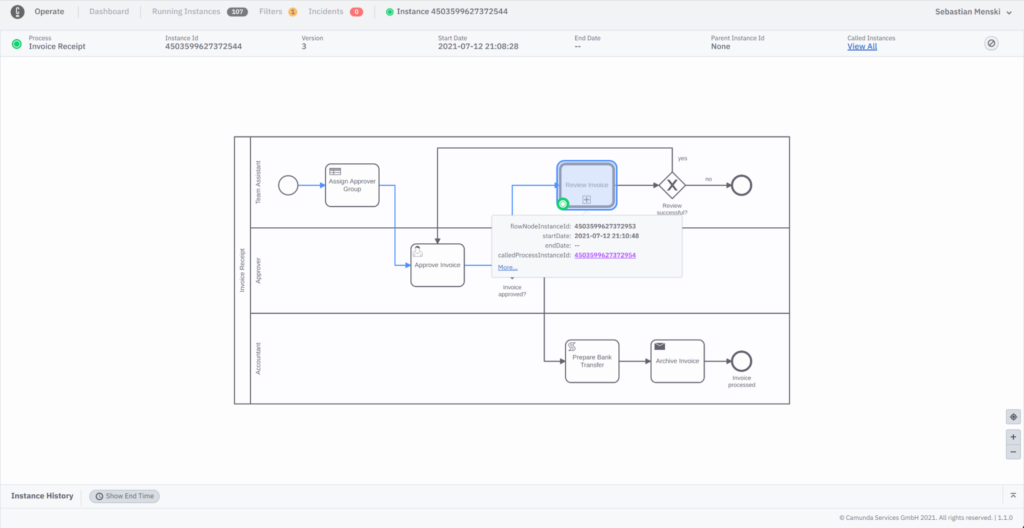
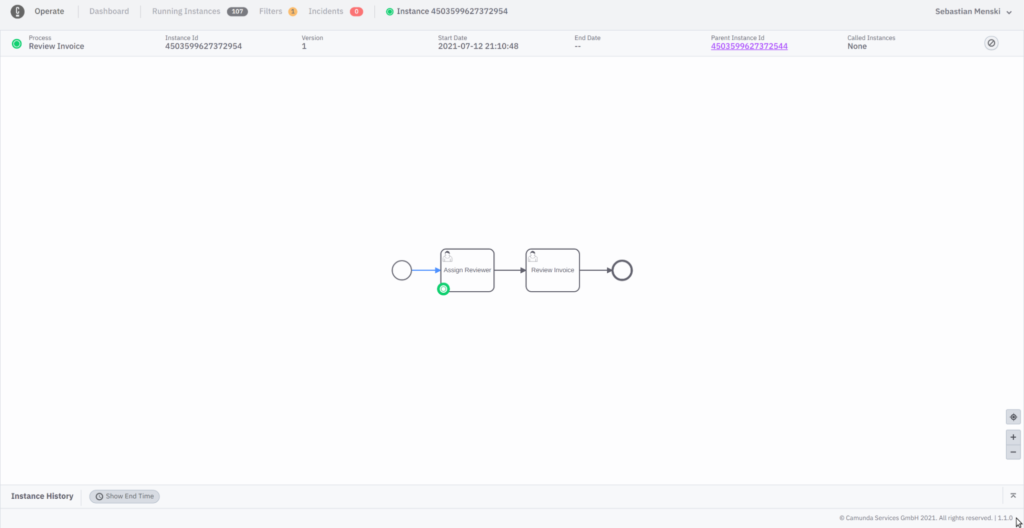
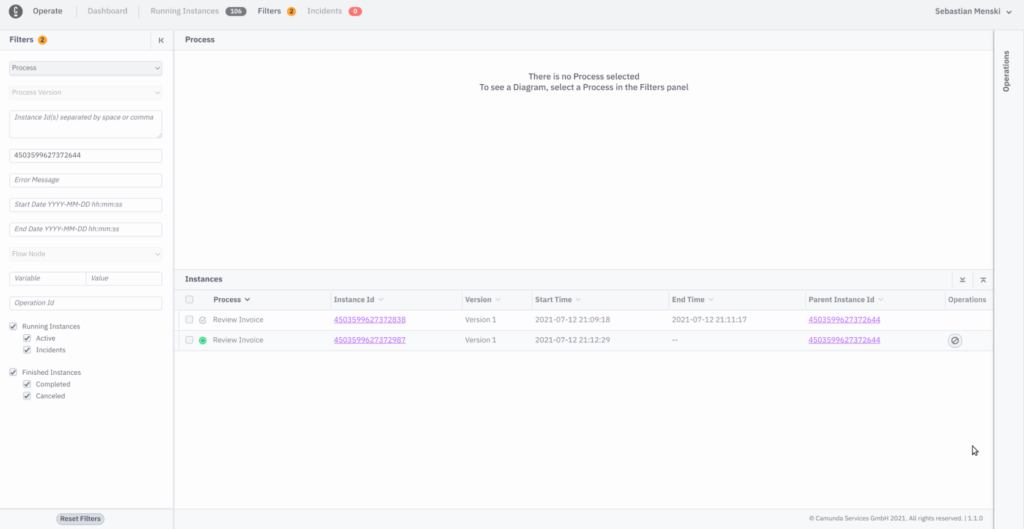
Advanced smart low-code functionality
The latest release of Camunda forms and Tasklist support new form fields which enable users to design the most common use cases. The following new form fields are now supported:
- Text field
- Number field
- Checkbox
- Radio buttons
- Select drop-down
With Camunda Cloud 1.1 you can use the new form fields in the Cloud Console. A Camunda Modeler release supporting the new form elements will follow.
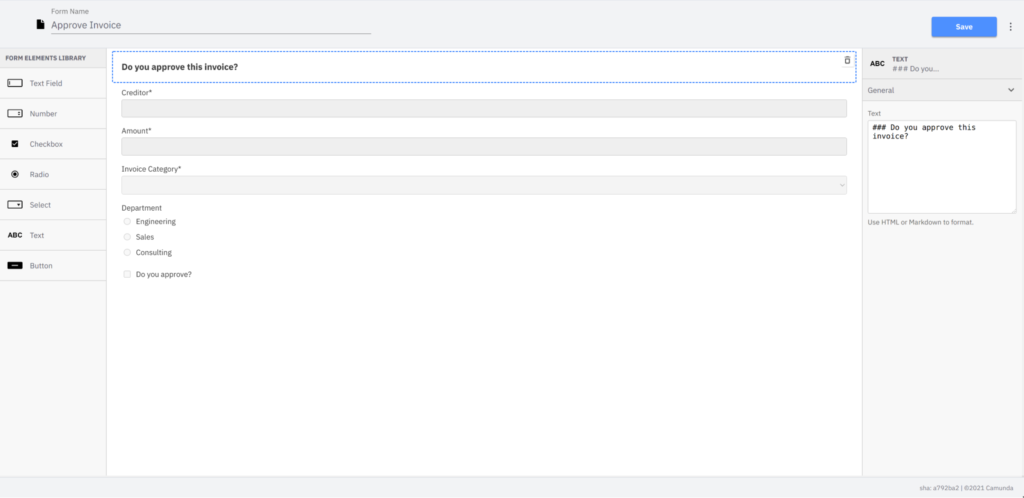
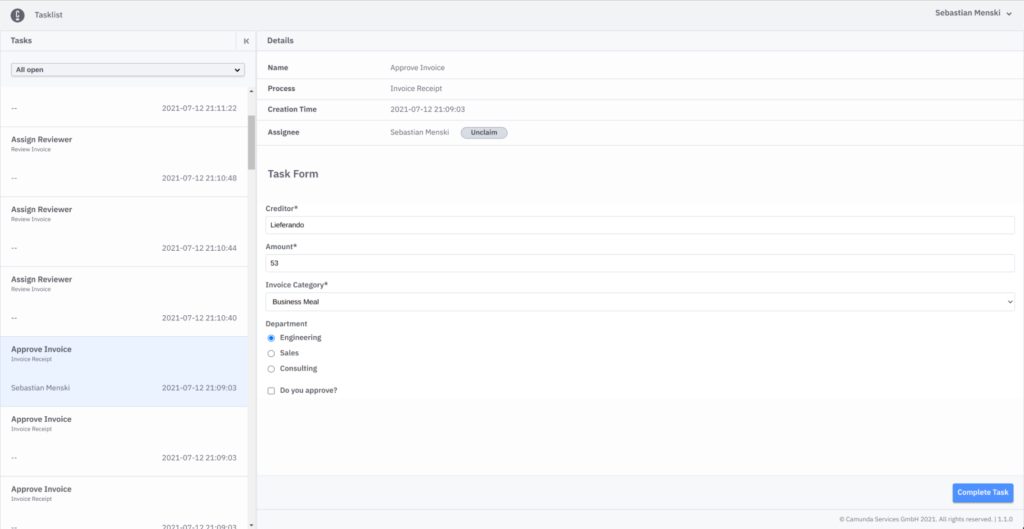
Improved user experience with Camunda Cloud Professional
We designed the Camunda Cloud professional plan with simplicity and self-service in mind. Furthermore, this plan is meant to provide a quick and easy entry point for a paid subscription — ideal for small teams to get started with Camunda Cloud. Moving forward, users can instantly upgrade or sign-up for the Professional plan with built-in credit card payment functionality, completely eliminating the need to speak with our sales team.
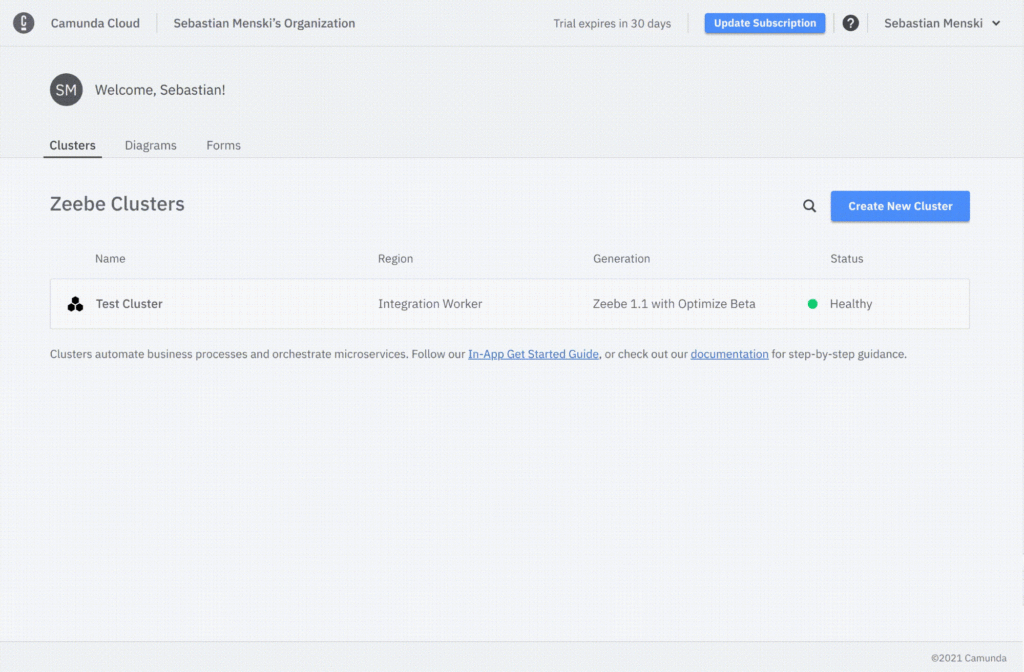
Real time process visibility
With this release, we’re excited to continue our vision of delivering the end-to-end process automation lifecycle. We’re now making Camunda Optimize available in a public beta — providing continuous monitoring and insights into your business processes. This Big Data solution helps process owners to make informed decisions in order to optimize their processes.
We are offering Optimize as a technical beta inside the alpha channel of the cluster creation. When you sign up as a new user, you will already have a test cluster provisioned which contains Optimize. We aim to deliver Optimize as a fully supported feature in the near future.
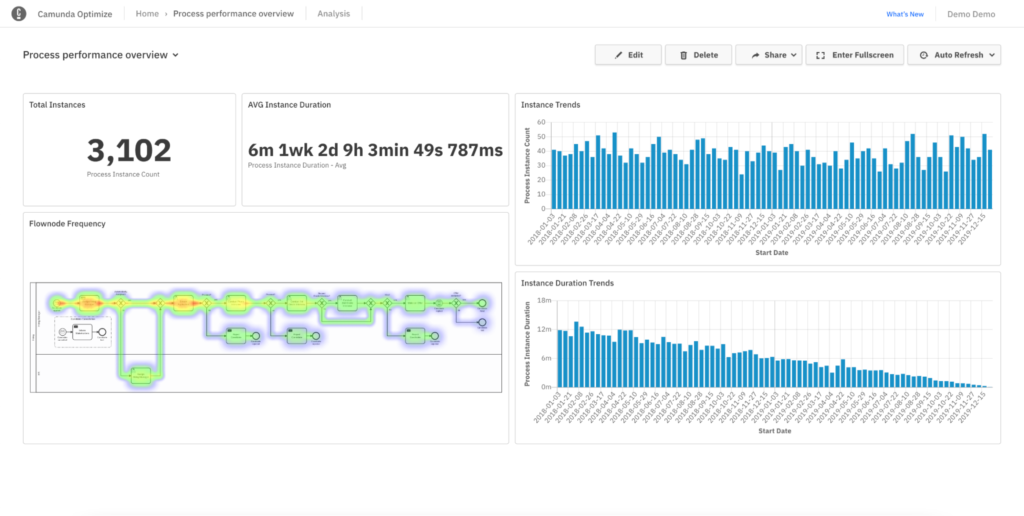
Further Improvements
Zeebe 1.1.0
Retry job if business error was thrown but not caught
It is now possible to resolve unhandled error event incidents attached to tasks. With the throw error client command you can indicate that a business error occurred during the processing of a job. If the thrown error is not caught in the process then an incident is raised. In the past, these incidents could not be resolved, because it is not possible to change the process of the instance where the incident exists. With Zeebe 1.1 it is finally possible to resolve these incidents. Resolving the incident will ignore the error, re-enable the job and allow it to be activated and completed by a job worker once again.
Distribute leaders uniformly in the cluster in a best-effort way
In Zeebe, there is no way to control which node becomes the leader of which partition. The raft leader election is based on randomized timeout value which is not controllable. As a result, leaders are frequently concentrated in a small number of nodes.
To address this problem, we have now added a new feature called priority based election which is disabled by default. You can enable it by setting zeebe.broker.experimental.enablePriorityElection to true. When this flag is enabled, the leader election algorithm attempts to elect the leaders based on a pre-defined priority. As a result, it tries to distribute the leaders uniformly across the brokers. Note that it is only a best-effort strategy. It is not guaranteed to be a strictly uniform distribution.
Detect segment descriptor corruption
We’ve made further improvements to Zeebe’s failure detection capabilities with respect to data storage. Zeebe’s internal event logs are stored in segments, each of which has a descriptor and is written to disk in a file. The segment file can become corrupted due to disk corruption or a crash while writing to the file. We had previously added capabilities to detect corruption in the records in a segment, with the latest release Zeebe can now detect corrupted segment descriptors too.
Split address and port in the Zeebe Go Client and zbctl
Thanks to another community contribution from Alexey Vinogradov, the Zeebe go client now supports setting the host and port. These serve as an easier way to specify the address, which always requires both the host and the port. When specifying either the host or the port, defaults for the other will be used to construct the address. The `ZEEBE_HOST` and `ZEEBE_PORT` environment variables can also be used to set the host and port respectively. These changes are also available in zbctl.
Operate 1.1.0
Improved handling of large variable sets
Besides the new features in Operate regarding Call Activity support, we have also improved the user experience for Process Instances with many variables and large variables. Previously, Operate users might have experienced longer loading times when opening the instance details view of an instance with a lot of variables or variables with large values. With the latest release of Operate, the UI now offers an endless scroll feature in the variables panel, similar to the endless scroll in the instance list view, therefore variables are loaded in chunks when the user scrolls down. Another issue was the loading of large variable values, which are now only loaded partially to reduce the initial loading time. With the new improvements, a large variable value will only be loaded fully when the user wants to edit the value.
Editing a large variable value can be quite challenging in the default input field in the variables field. Therefore we added the functionality to open the variable value in a code editor modal window. This gives you formatting and highlighting of the JSON variable value to better interact with it.
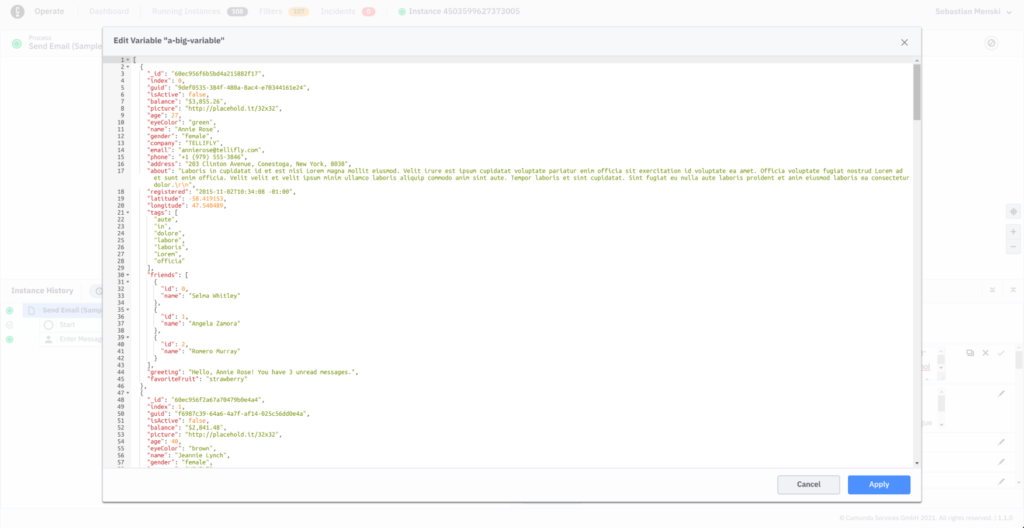
How to get it
You can make use of Zeebe, Operate and Tasklist 1.1.0 directly in Camunda Cloud by selecting the “stable” channel when creating a new cluster, for more information visit the Camunda Cloud docs.
The releases for Zeebe Engine, Operate, and Tasklist have also been published on GitHub and you can find the assets here.
Read more about updating your own installation of Camunda Cloud in our update guide.
